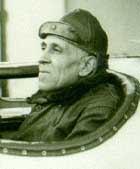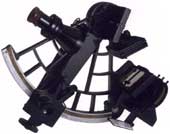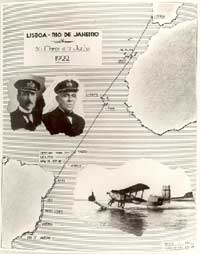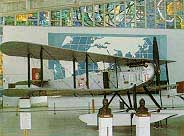|
|
||||||||||||||||
|
|
||||||||||||||||
|
|
||||||||||||||||
|
Gago Coutinho (1869-1959)
Carlos Viegas Gago Coutinho was born in Belém, Lisbon, on 17 February 1869. He was the son of José Viegas Gago Coutinho and Fortunata Maria Coutinho. In 1885, he concluded his secondary education and then enrolled at the Polytechnic in order to prepare his entrance into the Navy School one year later. He entered the navy as a naval cadet in 1886. In 1890, he was promoted to midshipman, in 1891 to second lieutenant and in 1895 he became first lieutenant. In 1907, he was promoted to the position of lieutenant and in 1915 to commander. In 1920, he became captain. In 1922, he was promoted to vice-admiral and in 1958 to admiral. In mid-1919, encouraged by Sacadura Cabral, when he was completing the work related to the geodesic mission of S. Tomé, Gago Coutinho started dedicating himself to the progress of aerial navigation methods. Cabral and Coutinho had flown together for the first time in 1917. Sacadura Cabral had already planned the aerial voyage to Brazil, which he intended making on the one-hundredth anniversary of the independence of this country, in 1922. Gago Coutinho therefore started dedicating himself to resolving the problems that faced aerial navigation with no points of reference on the surface. In order to try out the aerial navigation process under study, Sacadura Cabral and Gago Coutinho undertook several voyages together, including the first aerial voyage between Lisbon and Funchal in 1921, taking this opportunity to update the observation methods under development. These studies culminated in 1922 with the aerial voyage between Lisbon and Rio de Janeiro. He was a member of several scientific associations, namely the Academia das Ciências, the Academia Portuguesa de História, the Sociedade de Geografia de Lisboa and several Geography Societies of Brazil, among others. Gago Countinho died in Lisbon on 18 February 1959. What made Gago Countinho famous was his pioneering scientific work in astronomical aerial navigation and his first crossing of the Southern Atlantic between Lisbon and Rio de Janeiro with Sacadura Cabral. Right from the first time he flew with Sacadura Cabral in 1917, Gago Countinho tried to resolve the problems facing astronomical aerial navigation. One of the main problems was the difficulty in defining the line of the horizon at a normal flying height. The difficulty in making precise measurements of the flying position with an ordinary sextant raised problems of an instrumental and methodical nature. In order to resolve the problem of measuring the altitude of a celestial body without a sea horizon, Gago Countinho designed the first sextant with an artificial horizon that could be used on board aircraft. This instrument, which Gago Coutinho called the “precision astrolabe”, makes it possible to materialise an artificial horizon using a spirit-level and also has an electrical system lighting up the spirit-level, making night-time observations possible. Between 1919 and 1938, Gago Coutinho dedicated himself to perfecting this instrument, which was later manufactured and made known by the German constructor C. Plath under the name “System Admiral Gago Coutinho”.
In collaboration with Sacadura Cabral, he designed and built another instrument which they called the “Plaqué de abatimento” or “route corrector”, which made it possible to graphically calculate the angle between the longitudinal angle of the aircraft and the route to be followed, taking the intensity and direction of the wind into account. In order to verify the effectiveness of their methods and instruments, Gago Coutinho and Sacadura Cabral made several aerial voyages, one of which was the journey between Lisbon and Funchal in 1921, in approximately seven and a half hours. On this journey, Gago Coutinho performed 15 calculations of straight altitude lines and several observations of the strength and direction of the wind. According to his annotations, the navigation processes used “were sufficient to determine with precision any point away from the earth, as small as it might be, a resource which became essential in a projected aerial journey from Lisbon to Brazil”. The journey that finally demonstrated to the entire world the value of these instruments and methods was the aerial crossing of the South Atlantic Ocean, between Lisbon and Rio de Janeiro, between 30 March and 17 June 1922. After this journey and the subsequent homage and official receptions, Gago Coutinho continued to work for the Cartography Commission, dedicating most of his time to the history of the voyages of the discoveries in the fifteenth and sixteenths centuries, having published many texts in which he analysed the methods used and tried to explain how the Portuguese managed to navigate so far from the coast and to sight land in the fifteenth and sixteenth centuries. From his sail navigation experiences in several ships in which he rendered service, he tried to explain how the Portuguese used the most appropriate methods at the time to stand up to the winds and crosscurrents. He made several journeys in which he practised making observations using an astrolabe similar to those used by the Portuguese in the fifteenth century, comparing its results with those obtained in sextants and chronometers with the aid of a radio signal. From these studies he concluded that the experience of the Portuguese navigators of the time of the discoveries was decisive in making astronomical navigation possible and that journeys were duly planned based on experience and that their return routes were not the result of storms and other unforeseen events, as defended by some historians. Worthy of particular mention are his studies on the regime of winds and currents in the North Atlantic, which forced the Portuguese navigators to sail around the crosscurrents and winds in deep sea on return from Guinea or Mina. This manoeuvre, called the detour of Guinea or detour of Mina, and which Gago Coutinho habitually called “the off-sea detour“, started being practised in the mid-fifteenth century. By the start of the sixteenth century, it had become routine navigation.
Many other texts were published in two volumes edited by Teixeira da Mota: Obras completas de Gago Coutinho, Lisbon, Junta de Investigações do Ultramar, 1972.
Bibliography BOLÉO, José de Oliveira, Gago Coutinho e Sacadura Cabral, Lisboa, Sociedade de Geografia, 1972. CORRÊA, Pinheiro, Gago Coutinho, Precursor da Navegação Aérea, Porto, Portucalense Editora, 1969. Correia, José Pedro Pinheiro, LEMOS; Carlos M. Oliveira e, O Almirante Gago Coutinho, Lisboa, Instituto Hidrográfico, 2000. REIS, Manuel dos, CORTESÃO, Armando, Gago Coutinho Geógrafo, Coimbra, Junta de Investigações do Ultramar, 1970, sep. de Memórias da Academia das Ciências de Lisboa, Tomo XIII, 1969.
|
||||||||||||||||
 |
||||||||||||||||
|
|
||||||||||||||||
| © Instituto Camões 2003-2005 | ||||||||||||||||







